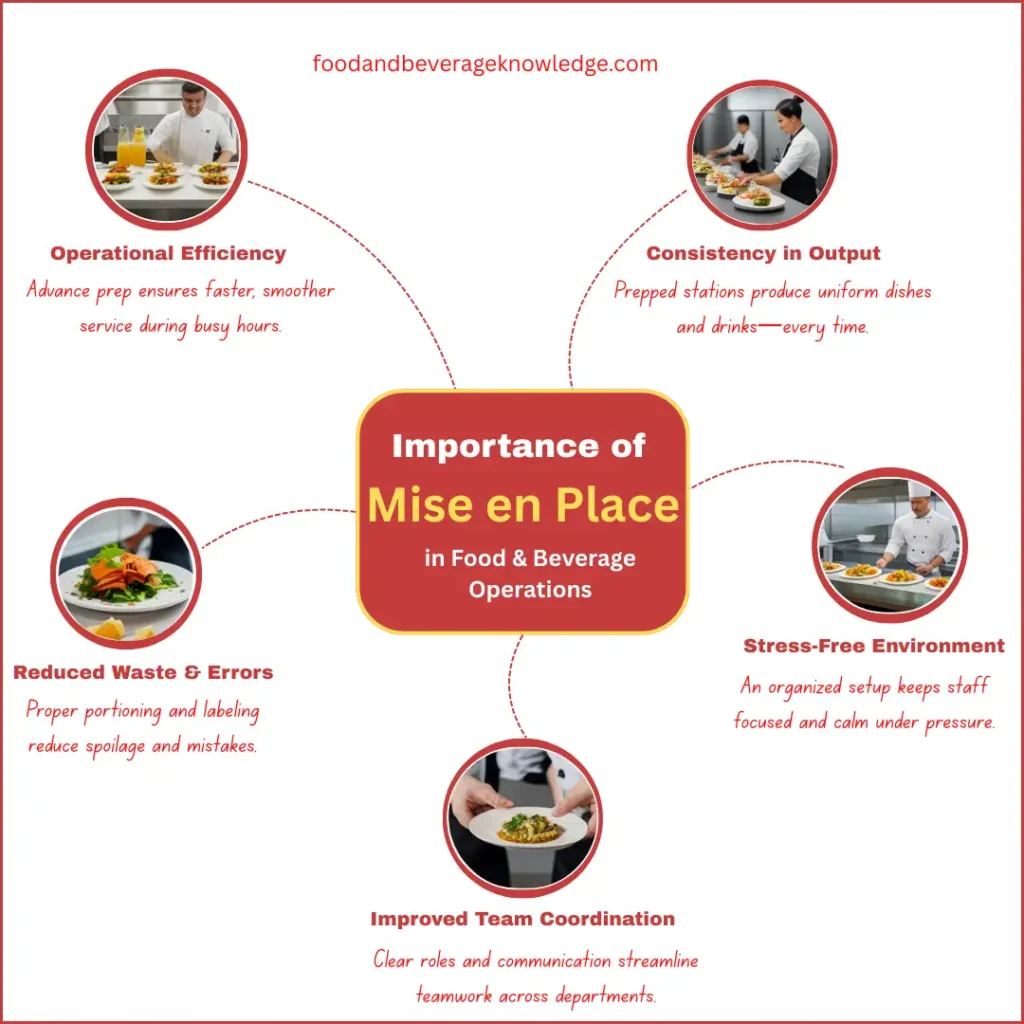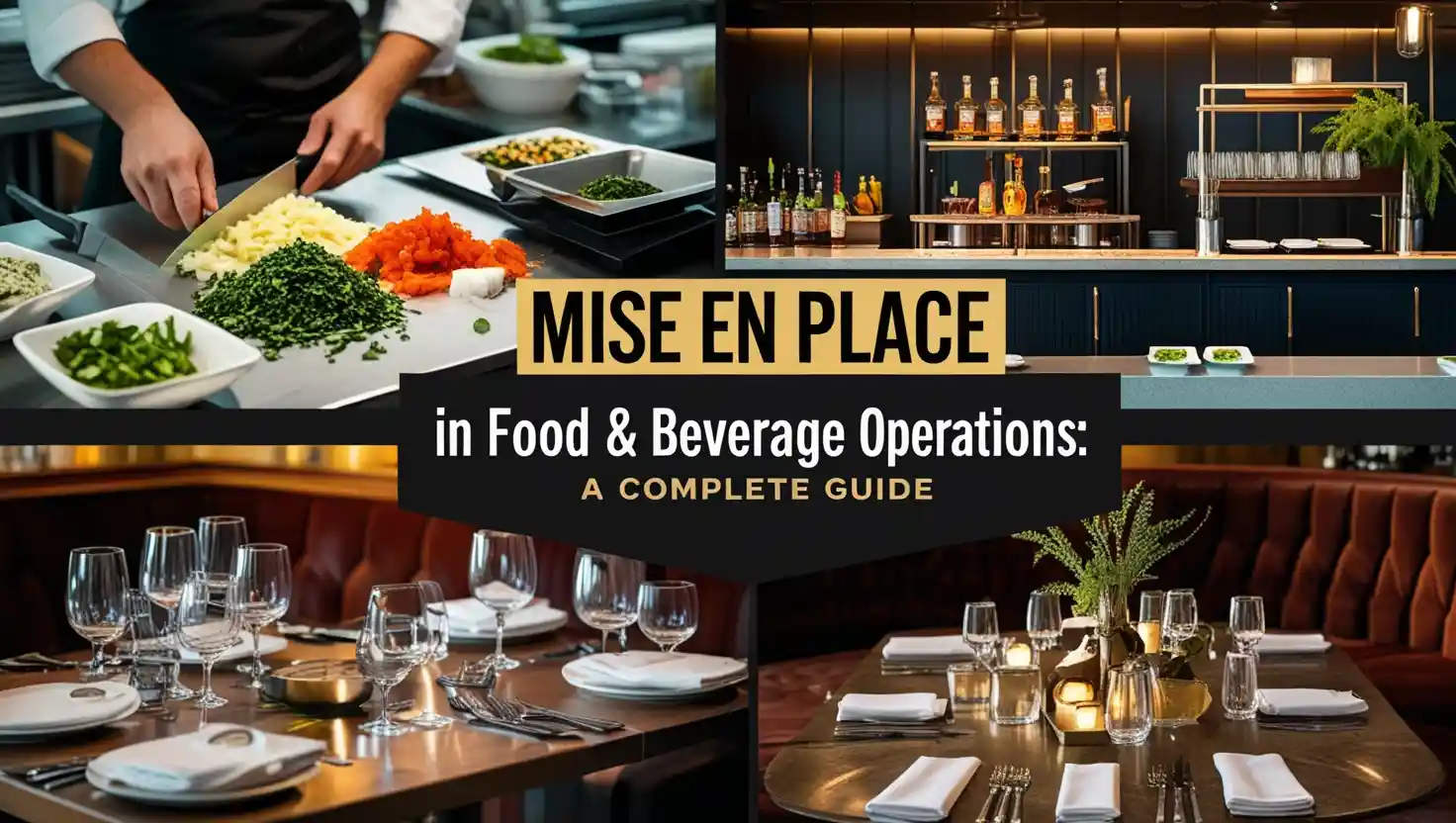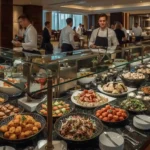Mise en Place (pronounced meez-on-plahs) is a foundational principle in the culinary and hospitality world. Originating from French, it translates to “everything in its place.” In food and beverage operations, this means preparing all ingredients, tools, and equipment before the service or production begins.
Whether in a commercial kitchen, a bar, or a fine dining restaurant, mise en place is key to operational excellence. It ensures that every element is organised, measured, and readily accessible for smooth execution.
This preparation boosts efficiency, enhances quality control, and supports consistent service delivery. Beyond just prepping food, it involves mental readiness and workflow discipline.
What Is Mise en Place in F&B?
Mise en place is the foundational practice in professional kitchens and service areas, involving the thorough preparation of all components required for service. This includes chopping vegetables, measuring ingredients, setting up workstations, and ensuring all necessary tools are readily accessible. The goal is to streamline operations, minimise errors, and maintain high standards of service.
Importance of Mise en Place in Food and Beverage Operations
In food and beverage operations—whether in a professional kitchen, bar, or restaurant floor—mise en place is the backbone of efficiency, quality, and consistency. It’s not just a culinary concept; it’s a mindset that applies to both food production and service delivery.

1. Operational Efficiency
By preparing ingredients, tools, and equipment in advance, mise en place allows chefs, bartenders, and service staff to work faster and more effectively. This streamlines workflow, reduces downtime, and improves overall productivity during busy shifts.
2. Consistency in Output
Whether it’s plating a dish or mixing a cocktail, mise en place ensures that every item is made to the same standard. It enables uniform quality and presentation, which is essential for guest satisfaction and brand reputation.
3. Reduced Waste and Errors
Proper portioning and preparation help prevent overproduction, spillage, and spoilage. This results in better inventory control, lower food costs, and a more sustainable operation.
4. Stress-Free Environment
An organised, well-prepped station reduces pressure during peak hours. Staff can work with greater focus and confidence, which enhances performance and morale.
5. Improved Team Coordination
When everyone follows mise en place protocols, team roles become clearer, communication improves, and service or production flows seamlessly. It supports a strong, collaborative work culture.
???? From the prep kitchen to the dining table, mise en place is the silent force that keeps food and beverage operations running smoothly.
Examples of Mise en Place in Different F&B Settings
Mise en place isn’t a one-size-fits-all approach—it varies across different food and beverage environments. Whether it’s a fine dining kitchen, a bustling cocktail bar, a full-service restaurant, or a large banquet hall, the principles remain the same: prepare, organise, and be ready. Let’s explore how mise en place applies across various operational zones in the hospitality industry.
Kitchen Mise en Place
In culinary production, mise en place is the backbone of kitchen efficiency. It refers to the preparation and setup of ingredients and equipment before actual cooking begins.
Key Elements:
- Ingredient Preparation: Washing, peeling, chopping, dicing, marinating, and portioning.
- Equipment Setup: Ensuring that knives, pans, tongs, mixing bowls, and measuring tools are clean, functional, and within reach.
- Station Organisation: Setting up the workstation with a logical flow—cutting boards, spices, containers, and pans arranged for optimal speed and safety.
✅ Kitchen Mise en Place Checklist:
- Chop and portion vegetables
- Marinate and portion proteins
- Prepare sauces, dressings, and stocks
- Sharpen knives and test for sharpness
- Sanitise and arrange cutting boards and utensils
- Set up mise-en-place bowls for spices and garnishes
- Label and date all prepped items for FIFO (First In, First Out)
- Ensure cold storage and hot holding units are functional
A well-executed kitchen mise en place not only boosts performance but is essential for maintaining food safety, consistency, and time management during service.
Bar Mise en Place
In beverage operations, mise en place helps bartenders deliver fast, consistent, and high-quality drinks. Proper bar setup can significantly impact guest satisfaction and sales performance.
Key Elements:
- Garnish Preparation: Slicing lemons, limes, oranges; prepping mint sprigs and berries.
- Stocking and Rotation: Organising and replenishing spirits, liqueurs, and mixers.
- Tool Arrangement: Ensuring shakers, strainers, muddlers, and glassware are clean, dry, and ready.
✅ Bar Mise en Place Checklist:
- Prepare and store fruit garnishes
- Stock ice bins and refill as needed
- Align glassware by drink type (highball, rocks, coupe)
- Check the availability of popular spirits and mixers
- Sanitise the work area and tools
- Prepare bar syrups, bitters, and premixes
- Print or write out drink specials for quick reference
Bar mise en place not only accelerates service speed but also reflects professionalism and brand image, key for guest retention in competitive beverage programs.
Restaurant Service Mise en Place
In front-of-house operations, mise en place ensures that the dining experience is seamless and elegant. A good FOH (Front of House) setup reflects attention to detail, hospitality standards, and readiness to serve.
Key Elements:
- Table Setting: Placing flatware, glassware, napkins, and chargers correctly.
- Station Stocking: Ensuring server stations have enough napkins, side plates, menus, and condiments.
- Guest Readiness: Checking reservations, allergies, and special notes.
✅ Restaurant Service Mise en Place Checklist:
- Lay table linens, silverware, and glasses
- Fill and polish water glasses and wine glasses
- Ensure the availability of updated menus and specials
- Stock side stations with plates, cutlery, condiments, and napkins
- Confirm reservation lists and table allocations
- Review daily briefings with the front-of-house team
- Ensure bathrooms, entryways, and waiting areas are clean
Effective mise en place in service contributes to guest satisfaction, faster table turns, and better reviews.
???? Banquet Mise en Place
Banquet operations, whether in hotels, catering setups, or convention centers, require large-scale mise en place planning. Due to the volume and variety of events—from weddings to conferences—banquet mise en place is critical for smooth event execution.
Key Elements:
- Mass Preparation: Scaling ingredients and food items for hundreds of covers.
- Equipment Coordination: Transporting and arranging chafing dishes, buffet setups, and service trays.
- Staff Allocation: Assigning service roles like butlers, runners, food passers, and clean-up crew.
✅ Banquet Mise en Place Checklist:
- Review the event banquet order (BEO) and guest count
- Pre-cook and portion bulk ingredients
- Organise buffet and plating lines by course (starters, mains, desserts)
- Set up beverage service stations (coffee, soft drinks, wine)
- Arrange table layouts and décor per event theme
- Assign staff roles and distribute service timelines
- Test sound systems, lighting, and presentation equipment
- Prepare dietary labels and signage for food stations
In banquets, mise en place must be done well in advance, often 1–2 days prior, to handle the complexity and scale of service. It is the foundation for timely, elegant, and large-scale food and beverage delivery.
Why Mise en Place Varies by Setting
Each F&B environment brings its own challenges:
- Kitchens demand speed, heat management, and plating consistency.
- Bars prioritise precision and showmanship.
- Restaurant service focuses on timing, table etiquette, and guest interaction.
- Banquets require logistics, volume handling, and coordinated teamwork.
Regardless of the environment, mise en place serves one universal purpose: to make service seamless, consistent, and stress-free.
Conclusion:
Mise en place is far more than a preparatory routine—it is a philosophy that underpins excellence in every corner of the food and beverage industry. Whether it’s the sharp precision of a chef in a fine-dining kitchen, the speed and flair of a skilled bartender, the grace of front-of-house service, or the large-scale coordination of banquet events, mise en place is what transforms chaos into calm and pressure into performance.
By embracing mise en place, F&B professionals don’t just prepare ingredients—they prepare themselves. It nurtures discipline, boosts confidence, enhances consistency, and lays the foundation for extraordinary guest experiences. For students of hospitality and seasoned professionals alike, mastering mise en place is not optional; it’s essential.
Related post
- Food & Beverage service SOPS for Restaurant, IRD & Banquet
- Food and Beverage Service 101: The Basics, Types, and Roles Explained
- What is Room Service in Hotels? A Comprehensive Guide
- Sequence of service in restaurants/ restaurant service procedure
Subscribe and join our community of hospitality professionals & students — get insights, tips, and the latest updates delivered straight to your inbox!







